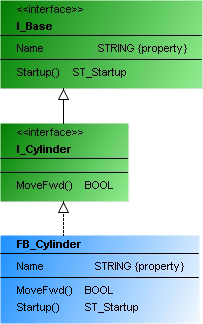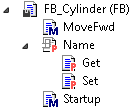Implementation
A realization is a UML relationship that expresses an interface implementation. The realizing or implementing class object (function block) implements the properties and methods of the interface. In IEC coding this relationship corresponds to the keyword IMPLEMENTS.

A realization is indicated by a dashed arrow, pointing from a class of type FUNCTION_BLOCK to an interface.
Property
|
“Property” |
Description |
|---|---|
|
“Relationship” |
Realization (not editable) |
Edit realization
|
User input in the class diagram |
Response in the class diagram |
Description |
|---|---|---|
|
Select the tool "Realization":
Select a class and then an interface. |
A realization is created, pointing from the class to the interface. |
The IEC code is automatically adapted to indicate the interface in the declaration section of the class. Example: FUNCTION_BLOCK FB_Sample IMPLEMENTS I_Existent |
|
Select the tool "Realization":
Select a class, then click in an empty area of the diagram. |
A realization is created, pointing from the class to the new interface. |
The IEC code is automatically adapted by creating a new interface and indicating this interface in the declaration section of the class. Example: FUNCTION_BLOCK FB_Sample IMPLEMENTS I_New |
|
Select the tool "Pointer“. |
|
The selected (and therefore blue) realization runs at the new position. |
|
Select the tool "Pointer“. |
|
The realization is removed from diagram and the IEC code. The IMPLEMENTS statement is removed from the declaration section of the class. |
Example
- Realization

INTERFACE I_Cylinder EXTENDS I_BaseFUNCTION_BLOCK FB_Cylinder IMPLEMENTS I_Cylinder
